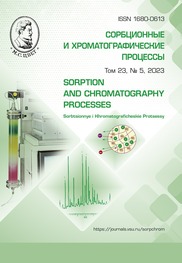Evaluation of the efficiency of coconut dust extract as a corrosion inhibitor for steel reinforcement in concrete by mass spectrometry
Abstract
Ethanol extraction was employed to isolate a range of compounds from waste products derived from coconut fiber production (coconut dust) in Ben Tre, Vietnam. Phytochemical screening confirmed the presence of flavonoids, tannins, polyphenols, saponins, alkaloids, flobatannins, and anthraquinones among the extracted substances. FT-IR spectroscopy analysis supported the identification of oxygen and nitrogen atoms within functional groups (e.g., O–H, N–H, C–O) and aromatic rings, characteristic of typical corrosion inhibitors. Mass spectrometry investigations indicated that when St3 steel was exposed to an alkaline solution lacking chlorides, a passive film composed of FeOOH formed on the surface. However, upon the addition of NaCl at a concentration of 1.00 mol/dm3, FeCl, FeCl2Cl–, and FeCl3Cl– compounds were detected across the analyzed surface, while peaks corresponding to FeOO– were absent. Remarkably, areas with the highest concentration of particles corresponded to regions exhibiting visible corrosion damage under magnification. The addition of 2.00 g/dm3 of coconut dust extract to the chloride solution prevents the formation of Fe and Cl compounds on the steel surface. Consequently, only peaks characteristic of FeOO– and organic fragments containing oxygen atoms from the extract were observed.
Based on these results, it can be assumed that coconut dust extract has the potential to inhibit local (pitting) corrosion of low-carbon steel (St3) when exposed to aqueous alkaline solutions simulating concrete pore liquid containing chlorides. The addition of 2.00 g/dm3 of the extract has been shown to prevent pitting formation at a chloride concentration of 1.00 mol/dm3. Conversely, in the absence of the extract, visible local corrosion damage was observed upon magnification. These findings provide a basis for further exploration of the protective properties of coconut dust extract as an environment-friendly corrosion inhibitor for mild steel in concrete environments containing chlorides.
Downloads
References
Tram T.T.N., Yen T.P., Anh T.T. et.al. Somatic embryogenesis of Polyscias fruticosa L. Harms via culturing ex vitro leaf explant. Vietnam Journal of Biotechnology. 2020; 18(3): 497-506.
Singh P., Dubey P., Younis, K. et. al. A review on the valorization of coconut shell waste. Biomass Conversion and Biorefinery. 2022; 1-11. https://doi.org/10.1007/s13399-022-03001-2
Haryanti P., Poetri R.K. Phytochemical Characteristic and Antimicrobial Ac-tivity of Coconut Coir Extract on Various Solvents. 3rd International Conference on Sustainable Agriculture for Rural Development (ICSARD 2022). 2023; 169-182. https://doi.org/10.2991/978-94-6463-128-919
Umoren S.A., Eduok U.M., Israel A.U. et. al. Coconut coir dust extract: a novel eco-friendly corrosion inhibitor for Al in HCl solutions. Green chemistry letters and Reviews. 2012; 5(3): 303-313. https://doi.org/10.1080/17518253.2011.625980
Liu Q., Song Z., Han H. et. al. A novel green reinforcement corrosion inhibi-tor extracted from waste Platanus acerifolia leaves. Construction and Building Materials. 2020; 260: 119695. https://doi.org/10.1016/j.conbuildmat.2020.119695
Liu Y., Song Z., Wang W. et. al. Ef-fect of ginger extract as green inhibitor on chloride-induced corrosion of carbon steel in simulated concrete pore solutions. Journal of cleaner production. 2019; 214: 298-307. https://doi.org/10.1016/j.jclepro.2018.12.299
Al-Akhras N., Mashaqbeh Y. Poten-tial use of eucalyptus leaves as green corro-sion inhibitor of steel reinforcement. Journal of Building Engineering. 2021; 35: 101848. https://doi.org/10.1016/j.jobe.2020.101848
Asmara Y.P., Kurniawan T., Sut-jipto A.G.E. et.al. Application of plants ex-tracts as green corrosion inhibitors for steel in concrete-A review. Indonesian Journal of Science and Technology. 2018; 3(2): 158-170. https://doi.org/10.17509/ijost.v3i2.12760
Asaad M.A., Hussein M.N., Al-kadhimi A.M. et. al. Commercial and green corrosion inhibitors for reinforced concrete structures: A Review. International Journal of Current Science Research and Review. 2021; 4(2): 89-99. https://doi.org/10.47191/ijcsrr/V4-i2-04
Abdulrahman A.S., Mohammad I., Mohammad S.H. Corrosion inhibitors for steel reinforcement in concrete: A review. Scientific Research and Essays. 2011; 6(20): 4152-4162. https://doi.org/10.5897/SRE11.1051
Abd El-Raouf M., Khamis E.A., Abou Kana M.T.H. et. al. Electrochemical and quantum chemical evaluation of new bis(coumarins) derivatives as corrosion inhibitors for carbon steel corrosion in 0.5 M H2SO4. Journal of Molecular Liquids. 2018; 255: 341-353. https://doi.org/10.1016/j.molliq.2018.01.148
Cao Nhat Linh, Shevtsov D.S., Nguyen Van Chi et. al. Evaluation of the applicability of an extract from the waste during coconut fiber processing as a corro-sion inhibitor of steel reinforcement in concrete. Butlerov Communications. 2022; 72(11): 30-35. https://doi.org/10.37952/ROI-jbc-01/22-72-11-30 (Russ.)
Ramesh T., Chauhan D.S., Quraishi M.A. Coconut Coir Dust Extract (CCDE) as green corrosion inhibitor for rebar’ steel in concrete environment. International Journal of Corrosion and Scale Inhibition. 2021; 10(2): 618-633. http://dx.doi.org/10.17675/2305-6894-2021-10-2-9
Kazitsyna L.A., Kupletskaya N.B. Application of UV, IR and NMR spectros-copy in organic chemistry. Moscow. High school. 1971. 264 p. (in Russ.)
Cao Nhat Linh, Nguyen Van Chi, Nong Quoc Quang et. al. Detection of chlo-rine ions on the surface of reinforcement steels after contact with the model envi-ronment by mass spectrometry. Chem-ChemTech [Izv. Vyssh. Uchebn. Zaved. Khim. Khim. Tekhnol.]. 2022; 65(6): 6-11. https://doi.org/10.6060/ivkkt.20226506.6520 (in Russ.)
Gerengi H., Sahin H.I. Schinopsis lorentzii extract as a green corrosion in-hibitor for low carbon steel in 1 M HCl so-lution. Industrial & Engineering Chemistry Research. 2012; 51(2): 780-787. http://dx.doi.org/10.1021/ie201776q
Li X., Liu J., Wang J. et. al. Micro-structure of passive film on steel in synthetic concrete pore solution in presence chlo-ride and nitrite. Int. J. Electrochem. Sci. 2019; 14: 8624-8638. https://doi.org/10.20964/2019.09.43
Hou D., Zhang K., Hong F. et. al. The corrosion deterioration of reinforced passivation film: The impact of defects. Applied Surface Science. 2022; 582: 152408. https://doi.org/10.1016/j.apsusc.2021.152408
Misawa T. The thermodynamic consideration for Fe-H2O system at 25C. Corrosion Science. 1973; 13(9): 659-676. https://doi.org/10.1016/S0010-938X(73)80037-X







